- Author: Kathy Keatley Garvey
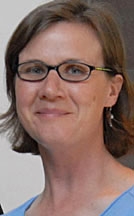
Nature has none. Zip. Zero. Zilch.
The Xerces Blue Butterfly, which once thrived on the San Francisco Peninsula before urbanization chased it away, is extinct.
There are no more. It “lives” only as specimens in several insect museums, including the Bohart Museum on the UC Davis campus.
Scientists at the Bohart Museum are spotlighting it on a t-shirt in an effort to draw attention to the fact that we need to protect our threatened and endangered species, or they, too, will become extinct like the Xerces Blue.
The t-shirt spreads the “E” word (Extinction). Lettered above the image of the dazzling blue butterfly (Glaucopsyche xerces) are the words: “And Then There Were None.”
“Some folks have asked us why we created a t-shirt featuring an extinct butterfly,” said t-shirt designer Fran Keller, a doctoral candidate in entomology based at the Bohart. “It not only makes the public aware of the fragility of insects but also shows how much research is still needed to be aware of the interactions between humans and insects and the overall impact his has on the environment.”
“The concept,” Keller said, “is that we will lose what we don’t know we have.”
Davis naturalist-photographer Greg Kareofelas made the images from specimens locked away in the Bohart Museum.
The butterfly, endemic to the San Francisco Peninsula, was first described and documented in 1852. Scientists believe it became extinct in the early 1940s due to human disturbance: loss of habitat caused by urban development.
The butterfly drew its name from the French spelling of "Xerxes," the name of Persian kings Xerxes I and Xerxes II of the fifth century BC.
Entomologist W. Harry Lange (1912-2004) unknowingly collected what is now considered the last known specimen. Lange, who donated some 1 million insect specimens to the museum during his entomological career, collected it at the Presidio military base on March 23, 1941. He later reportedly lamented “I always thought there would be more. I was wrong.”
Only a few U.S. museums, including the Bohart Museum, California Academy of Sciences and the Harvard Museum of Natural History, have specimens of the Xerces Blue (family Lycaenidae), Keller said.
The Bohart Museum, home of more than seven million insect specimens, houses the seventh largest insect collection in North America and is dedicated to teaching, research and service. Founded in 1946 by UC Davis entomologist Richard M. Bohart and now directed by Lynn Kimsey, UC Davis professor of entomology, the museum aims to educate the public about insect diversity, conservation and preservation as part of its mission.
The T-shirt is available online and at the Bohart Museum, 1124 Academic Surge, California Drive, UC Davis campus.
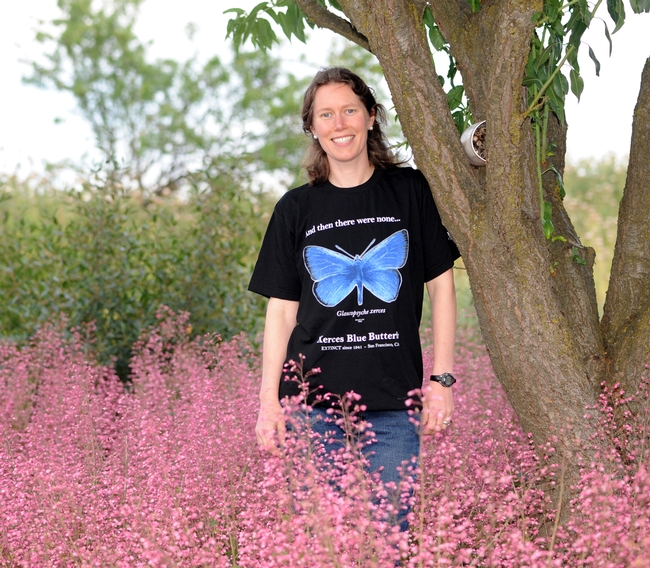
- Author: Kathy Keatley Garvey
Unlike the Saints, the ants won't "go marching in"; they'll be "marching on."
The "Ants Go Marching On” will set the theme for the Bohart Museum of Entomology's open house from 1 to 4 p.m., Sunday, March 13 at 1124 Academic Surge, California Drive, UC Davis campus.
There you can learn about ants from myrmecologists--those are the folks who study ants.
Admission is free.
Ant specialist and doctoral candidate Bonnie Blaimer of the Phil Ward lab will engage the visitors with a slide show of a collecting trip to Madagascar. She and fellow doctoral candidate Marek Borowiec, also of the Phil Ward lab, will be discussing characteristics of ants and answering questions.
The Bohart is home to more than seven million insects.
“The Hymenoptera (bees, ants and wasps) form about 30 percent of the Bohart collection,” said Tabatha Yang, education and outreach coordinator.
The Bohart Museum also has a live “petting zoo” that includes Madagascar hissing cockroaches and walking sticks; and a gift shop where visitors can purchase such items as t-shirts, sweat shirts, posters, jewelry and insect candy.
The R. M. Bohart Museum of Entomology, directed by Lynn Kimsey, professor of entomology at UC Davis, was founded in 1946 by noted entomologist Richard M. Bohart. Dedicated to teaching, research and service, it houses the seventh largest insect collection in North America.
The museum holds specimens collected worldwide and is the home of the California Insect Survey, a storehouse of the insect biodiversity of California’s deserts, mountains, coast and great central valley.
The museum’s regular hours are from 8:30 a.m. to noon and from 1 to 5 p.m., Monday through Thursday. It is closed on Fridays and on major holidays. More information is available on the Bohart website or by contacting Tabatha Yang at tabyang@ucdavis.edu or (530) 752-9464. Due to limited space, group tours will not be booked during the weekend hours.
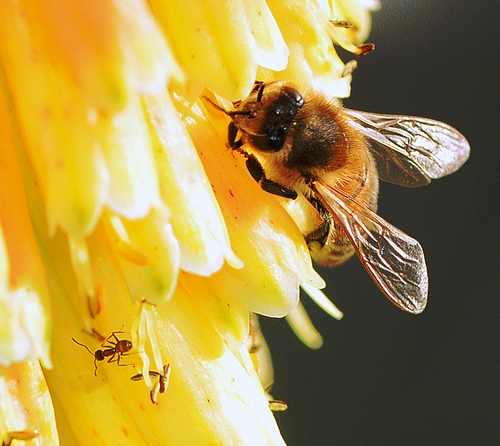
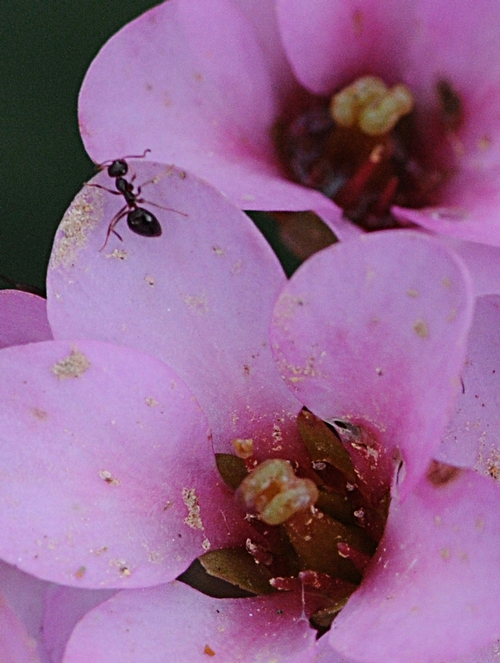
- Author: Kathy Keatley Garvey
When the Antioch Charter Academy, a middle school in Contra Costa County, toured the Harry H. Laidlaw Jr. Honey Bee Research Facility at UC Davis on Tuesday, May 4, they learned all about honey bees and native bees.
Tour coordinator Tabatha Yang, education and outreach coordinator for the Bohart Museum of Entomology set up three activity stations, visited by groups of 13.
Extension apiculturist Eric Mussen, member of the UC Davis Department of Entomology faculty, talked to them about bee biology, bee communication and colony collapse disorder; Yang and native pollinator specialist Robbin Thorp, emeritus professor of entomology, discussed bee diversity, bee monitoring, bee identification and foraging behavior; and to top it off, bee breeder-geneticist Susan Cobey and Elizabeth Frost displayed bee equipment, discussed the breeding program and then opened several hives.
The students singled out the three castes: queen bee, drones and worker bees. They admired the many different colors of pollen. They gingerly picked up drones (male bees have no stingers).
Then at the urging of Cobey and Frost, the teenagers dipped their fingers into the honey.
Straight from the hive.
Their verdict: "Wow, this is good!"
A taste of honey, a picture of contentment, and a greater admiration for the work of honey bees.



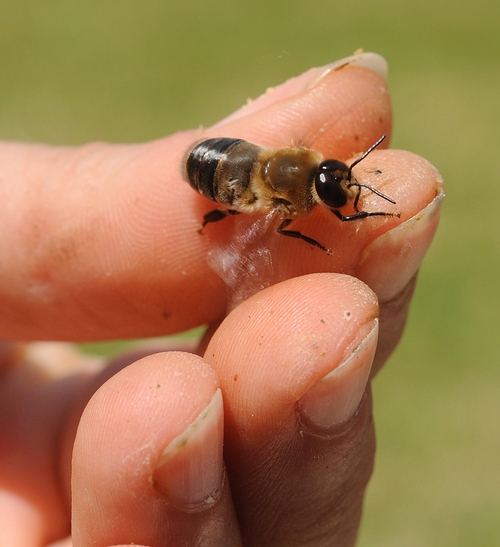
- Author: Kathy Keatley Garvey
What has six legs and is green all over?
If you think like an entomologist, that's easy.
Walking sticks, walking leaves, mantids, crickets and grasshoppers...The Bohart Museum of Entomology, which houses more than seven million specimens--plus a live "petting zoo"-- is gearing up for a Sunday event featuring a St. Patrick's Day theme.
The Bohart Museum, located at 1124 Academic Surge on the UC Davis campus, will be open from 1 to 5 p.m., Sunday, March 21, to focus on what's green.
No, Bohart Museum director Lynn Kimsey won’t be dressed as a leprechaun. The museum isn’t changing its name to the “O’Bohart.” There’s no pot of gold anywhere in the museum. No shamrocks or “Danny Boy,” either.
But, yes, there will “wearing o’ the green,” said Tabatha Yang, education and outreach coordinator for the Bohart.
Many insects are green.
“The live green ones are walking sticks and walking leaves,” she said. A new addition to the Bohart is a six-inch walking stick that’s a bright kelly green. “This is what inspired the St. Patrick’s Day connection,” Yang said.
*While the four-leaf clover is the luck symbol of St. Patrick’s Day, some cultures in Europe and Asia consider green crickets lucky," Yang said, "so we will have some crickets and grasshoppers from the collection on display.”*
“People will see that not all crickets are green or even brown, but they can be black or reddish or yellowish.”
Senior museum scientist Steve Heydon says he’ll feed the Madagascar hissing cockroaches some cabbage—no corned beef, though.
The first 50 visitors wearing green will receive a free Bohart Museum bookmark," Yang said.
The Bohart Museum recently extended its hours to include several Saturdays or Sundays. A Valentine’s Day theme, “What Is a Kissing Bug?”, highlighted the Saturday, Feb. 13 opening.
The next special events: the all-day UC Davis Picnic Day on Saturday, April 17 and then the cleverly named MOTH-er’s Day, in celebration of moths, on Saturday, May 8 from 1 to 5 p.m.
MOTH-er's Day is the day before the "real" Mother's Day on Sunday, May 9.
“The weekend openings are in response to working people and parents who can't visit us during the week,” Yang said. The gift shop also will be open. Visitors can purchase T-shirts, posters, stickers and “insect candy,” among other items.
The Bohart, closed on Fridays, is open weekdays, Monday through Thursday from 8:30 a.m. to noon and from 1 to 5 p.m. Tours can be arranged by contacting Yang at tabyang@ucdavis.edu or (530) 752-0493 or (530)-752-9464. “Due to limited space, groups need to call ahead and book a tour other than on the weekend openings,” she said.
The Bohart Museum, founded in 1946 by the late Richard M. Bohart, former chair of the UC Davis Department of Entomology, is directed by Lynn Kimsey, professor and vice chair of the UC Davis Department of Entomology.
Dedicated to teaching, research and service, the museum houses the seventh largest insect collection in North America. The museum also includes live insects such as Madagascar hissing cockroaches, walking sticks and walking leaves in the "petting zoo."


- Author: Kathy Keatley Garvey
The Bohart Museum of Entomology, which houses more than seven million insect specimens at its facility on the University of California, Davis campus, has extended its hours to include several weekends.
The first will be Saturday, Feb. 13 from 1 to 5 p.m., and the theme focuses on Valentine's Day.
The theme? "What Is a Kissing Bug?"
The Bohart Museum, located at 1124 Academic Surge, also will be open on two other Saturdays and a Sunday. Think St. Patrick’s Day, UC Davis Picnic Day and Mother’s Day.
“The weekend openings are in response to working people and parents who can't visit us during the week,” said Tabatha Yang, the Bohart's education and outreach coordinator.
“For these events we'll be highlighting some of the animals at the Bohart which get overlooked,” Yang said. “On Feb. 13, we’ll let the kissing bugs have their 15 minutes of fame.”
On Sunday, March 21, in keeping with St. Patrick’s Day, the theme is “What Has Six Legs and Is Green All Over?” Hours are from 1 to 5 p.m.
Saturday, April 17 is the traditional UC Davis Picnic Day, when the Bohart will be open throughout the day.
Saturday, May 8 will be “Moth-ers Day,” an event focusing on moths from 1 to 5 p.m.
The Bohart is open weekdays, Monday through Thursday from 8:30 a.m. to noon and from 1 to 5 p.m., and is closed on Fridays. Group can arrange tours by contacting Yang at tabyang@ucdavis.edu or (530) 752-0493 or (530)-752-9464. “Due to limited space, groups need to call ahead and book a tour other than on the weekend openings,” she said.
The Bohart Museum, founded in 1946 by the late Richard M. Bohart (1912-2007), a noted entomologist and former chair of the UC Davis Department of Entomology, is directed by Lynn Kimsey, professor and vice chair of the UC Davis Department of Entomology.
Dedicated to teaching, research and service, the museum houses the seventh largest insect collection in North America. The museum's "petting zoo" includes live insects such as Madagascar hissing cockroaches, tiger hissing cockroaches (also from Madagascar), mantids, and assorted walking sticks and walking leaves.
First-year graduate student Emily Bzdyk, who studies at the Bohart with major professor Lynn Kimsey, is among those intrigued by all the insects there, including the tiger hissing cockroaches (Gromphadorhina grandidieri). (Bzdyk is also a very talented artist and photographer.)



